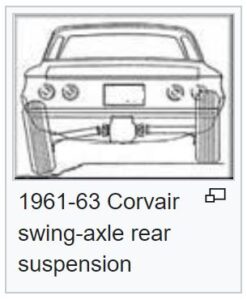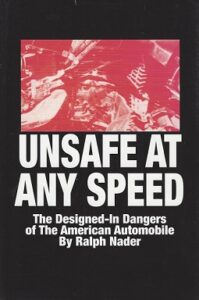 When the automobile was invented, everyone rightly thought it was going to be the “end all, beat all” of transportation inventions. In many ways, it probably was just that…at that time anyway, but as with any form of transportation, when it’s very new, it’s also very flawed. By its very nature, and invention is often trial and error. On November 30, 1965, a 32-year-old lawyer named Ralph Nader saw something in the automobile that caused him to become very concerned…concerned enough to write a book about his findings. Nader called his book Unsafe at Any Speed: The Designed-In Dangers of the American Automobile. Just the title of the book is enough to worry the thinking consumer…or maybe what would have been the “overthinking” consumer.
When the automobile was invented, everyone rightly thought it was going to be the “end all, beat all” of transportation inventions. In many ways, it probably was just that…at that time anyway, but as with any form of transportation, when it’s very new, it’s also very flawed. By its very nature, and invention is often trial and error. On November 30, 1965, a 32-year-old lawyer named Ralph Nader saw something in the automobile that caused him to become very concerned…concerned enough to write a book about his findings. Nader called his book Unsafe at Any Speed: The Designed-In Dangers of the American Automobile. Just the title of the book is enough to worry the thinking consumer…or maybe what would have been the “overthinking” consumer.
Still, the book became a best-seller right away. It also triggered the passage of the National Traffic and Motor Vehicle Safety Act of 1966…seat-belt laws in 49 states…all but New Hampshire. It also triggered a number of other road-safety initiatives. The original automobile really did have some serious safety flaws, and while a lot of people would argue that the seatbelt doesn’t prevent death in accidents, the reality is that it prevents many of those deaths, and the ones that seatbelts don’t prevent, are so bad that nothing would have prevented death.
These days, Ralph Nader is known for his role in national politics, running unsuccessfully for President of the United States four times…running with the Green Party in 1996 and 2000, the Reform Party in 2004, and as an independent in 2008. In each campaign, Nader said he sought to highlight under-reported issues and a perceived need for electoral reform. He received nearly three million votes during his 2000 candidacy, but also stirred controversy over allegations that his campaign helped Republican candidate George W Bush win in a highly contested election against Democratic candidate Al Gore.
Nader’s book placed the automobile in a negative light for the 50 years prior to the releases of the book, saying  that “the automobile has brought death, injury, and the most inestimable sorrow and deprivation to millions of people.” His real complaint was that technology existed at that time to make cars safer, but automakers had little incentive to use them. He thought that the automakers skipped the important steps that could have brought about a much safer vehicle. He wrote that on the contrary, “the gigantic costs of the highway carnage in this country support a service industry,” meaning doctors, lawyers, police officers, morticians, with no real plans to change things and “there is little in the dynamics of the automobile accident industry that works for its reduction.”
that “the automobile has brought death, injury, and the most inestimable sorrow and deprivation to millions of people.” His real complaint was that technology existed at that time to make cars safer, but automakers had little incentive to use them. He thought that the automakers skipped the important steps that could have brought about a much safer vehicle. He wrote that on the contrary, “the gigantic costs of the highway carnage in this country support a service industry,” meaning doctors, lawyers, police officers, morticians, with no real plans to change things and “there is little in the dynamics of the automobile accident industry that works for its reduction.”
Nader’s book brought to light some of the harsh truths, or rather serious flaws, about and in cars and car companies that auto-safety advocates had known for some time, and seemingly done nothing about. Nader pushed hard against the automakers, and in 1956, at a series of Congressional hearings on traffic safety, doctors and other experts lamented the “wholesale slaughter” on American highways. Safety measures had all but been ignored, and that year, nearly 40,000 people were killed in cars, with no sign of a decrease in numbers on the horizon. If the consumers wanted the much-needed safety features, they could pay extra for a Ford with seatbelts and a padded dashboard, but very few did. It was estimated that only 2% of Ford buyers took the $27.00 seatbelt option. The auto industry not only made it more costly to get the safety features, but downplayed the importance of it.
In his book, Nader particularly ranted against the Chevy Corvair, a sporty car with a swing axle and rear–mounted engine that was introduced in 1959, saying that the car epitomized the triumph of “stylistic  pornography over engineering integrity.” The swing axle made the rear end unstable, causing it to “tuck under during turns and skid or roll over much more frequently than other cars did.” As it turned out, a 1972 government study vindicated the Corvair, finding that it was just as safe as any other car. I couldn’t say one way or another, but Nader called that study “rigged.” Nevertheless, the damage was done. The Corvair became an icon of dangerous, even deadly design, which was later proven to e the case. The last one rolled off the assembly line in 1969. I suppose the auto industry is a heavily funded group, and it would be easy to “fix” the numbers to say what they wanted to say.
pornography over engineering integrity.” The swing axle made the rear end unstable, causing it to “tuck under during turns and skid or roll over much more frequently than other cars did.” As it turned out, a 1972 government study vindicated the Corvair, finding that it was just as safe as any other car. I couldn’t say one way or another, but Nader called that study “rigged.” Nevertheless, the damage was done. The Corvair became an icon of dangerous, even deadly design, which was later proven to e the case. The last one rolled off the assembly line in 1969. I suppose the auto industry is a heavily funded group, and it would be easy to “fix” the numbers to say what they wanted to say.
Nader’s book mobilized a mass movement. Armed with the truth, ordinary consumers banded together to demand safer cars and better laws. When consumers take a stand, things can, and do happen. Today, seat belts, air bags, anti-lock brakes and other innovations are standard features in almost every new car. I don’t know what kind of a politician Ralph Nader was or is, but in this one thing anyway, he did something good.

